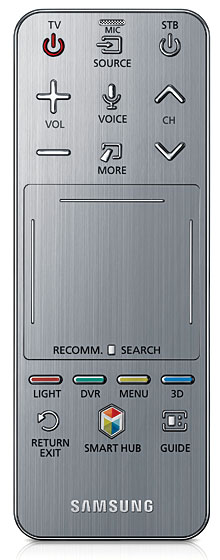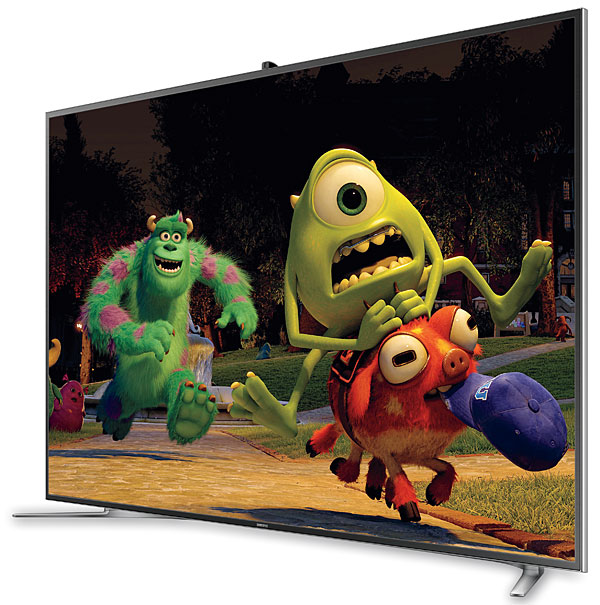Samsung UN65F9000 3D LCD/LED Ultra HDTV Page 2
The set’s screen uniformity is good but, as with all of the LCD sets we’ve seen, not perfect. There’s a little cloudiness on a full gray screen, with the edges slightly brighter than the center. But neither of these issues was distracting on normal program material.
 Viewed side by side with Panasonic’s equally sized TC-P65ZT60 plasma in 2D, the Samsung held its own in most respects. As expected, the Panasonic wouldn’t go as bright at its maximum linear settings. But with both TVs dialed in to a comfortable 30 to 32 foot-lamberts, brightness differences between the two sets were only occasionally visible. Average scenes looked equally bright on both of them, but full-screen, very bright scenes were noticeably punchier on the Samsung. There’s a technical reason for this—plasma designs limit their brightness automatically as the percentage of the screen filled with a bright image increases; LCDs do not. This can be a plus for an LCD set when you have room lights on but can also be occasionally uncomfortable for watching movies in the dark.
Viewed side by side with Panasonic’s equally sized TC-P65ZT60 plasma in 2D, the Samsung held its own in most respects. As expected, the Panasonic wouldn’t go as bright at its maximum linear settings. But with both TVs dialed in to a comfortable 30 to 32 foot-lamberts, brightness differences between the two sets were only occasionally visible. Average scenes looked equally bright on both of them, but full-screen, very bright scenes were noticeably punchier on the Samsung. There’s a technical reason for this—plasma designs limit their brightness automatically as the percentage of the screen filled with a bright image increases; LCDs do not. This can be a plus for an LCD set when you have room lights on but can also be occasionally uncomfortable for watching movies in the dark.
With its exceptional black level and shadow detail, the Panasonic remained the champ in those respects. With Smart LED on Standard (which I used for all of my viewing), the Samsung nevertheless performed admirably on all but the most challenging dark scenes, and even then never poorly. But in a darkened room, the star fields and cave scenes in Prometheus, the low-contrast scenes in Harry Potter and the Deathly Hallows: Part 2, and the black bars on these and other 2.35:1 movies grabbed the Panasonic an A+ score next to the Samsung’s B. Oddly, however, the Samsung’s black letterbox bars—which were a somewhat distracting, dark gray in a dimmed room next to the inky bars on the Panasonic—appeared a hair blacker than the Panasonic’s in average room lighting.
There was little to choose from between the sets with regard to color. They weren’t absolutely identical—even after calibration, no two sets using different technologies ever will be—but there was no way to declare one better than the other. The Samsung also looked a little sharper and at the same time smoother (a combination noted earlier), but the Panasonic hardly looked soft.
The Samsung had the usual off-axis limitations generic to most LCD sets, while the Panasonic could produce a good picture from any practical viewing angle. As to motion blur, even with the Samsung’s Auto Motion Plus (motion interpolation) turned off (my preferred setting), I was never really bothered by blurring—though the Panasonic plasma did appear to have a slight motion advantage if I looked intensely for it.
2K Performance in 3D
Lack of brightness is a major issue on most 3D displays, but not on the Samsung. Even with the Backlight control on 14 out of a maximum of 20 in the Movie Picture Mode (the set can save different settings for 2D and 3D in the same Picture Mode), the TV produced more than 15 ft-L for a bright, punchy picture. It wasn’t the brightest 3D I’ve ever seen, but it was close, and I enjoyed 3D on this set as much as I have on any other display, and far more than on most.

I did see a little 3D crosstalk on one of my usual suspects (director Robert Zemeckis’ 3D version of A Christmas Carol), but there was none I could see on another frequent offender (Despicable Me). Crosstalk is a bit more likely to raise its head here, on occasion, than on sets using passive 3D glasses. But overall, for me, it wasn’t an issue.
The pre-calibration 3D color wasn’t distractingly wrong, particularly since most 3D material, being animated, is relatively forgiving of color errors. But a lack of blue did drive the Delta E numbers well beyond the acceptable range. Captain America looked a bit too sepia-toned. The blue shortcoming wasn’t evident on Avatar, however, as director James Cameron uses a more than generous blue emphasis in all of his movies. In any case, a 3D calibration cured the issue completely (see Test Bench).
Conclusions
Is it time for you to consider buying an Ultra HDTV? Prices are dropping, but not exactly at terminal velocity. If you want a top-level Ultra HD set, it’s still going to cost you. The technology’s specs are still fluid. While the 4K sources likely to make their way into your hands over the next few years should be playable on this Samsung (possibly with an upgrade of the One Connect box), and should look great doing so, there’s no guarantee that the UN65F9000 (or any other current 4K set) will get the most to be had out of sources produced from the final specs. Those enhancements might well include expanded color capabilities, an improvement that could very well be more visibly significant than Ultra HD’s increased resolution—at least on a set this size viewed from a normal viewing distance.
Nevertheless, this is a superb set for both the 2D and 3D sources we have now, and one of the best performers I have reviewed. It might require a bit of a leap of faith to jump into 4K at this early juncture, but if you’re an adventurous early-adopter, you’re unlikely to be disappointed.








































